Dentures
DENTURES
Dentures are artificial teeth placed in a base material made of acrylic coloured and shaped to look like gum tissue. Dentures can replace one tooth or a whole arch of missing teeth.
Dentures are not fixed and need to be taken out of the mouth to clean.
FULL DENTURES:-
Full dentures are made when all natural teeth are missing. Specially made denture teeth are held in place by an acrylic base and rests on the gums.
Full upper or complete (maxillary) dentures are much more stable than full lower (mandibular) dentures. Full upper dentures cover a larger surface area and suction can usually be achieved in the upper arch.
Full lower (mandibular) dentures tend to be less stable as lower dentures cover a much smaller surface area and any movement of the jaw and tongue muscles tend to dislodge the lower denture. Patients have to learn to control the lower denture and take longer to get used to them.
Advantages:
Suitable for those that have lost all their teeth.
Some patients cannot maintain their teeth and are likely to loose multiple teeth in a short time period.
Where extensive treatment is not appropriate and where costs factors are an issue.
Disadvantages:
People with dentures have only about one third the chewing power as people with teeth.
Some loss of taste and sensation can be expected as all the gum is covered by the denture base.
When teeth are lost the underlying bone resorbs or shrinks causing changes in the shape of the jaw and gums. Most of the change takes place in the first three months after an extraction. The bone continues to shrink and change shape at a slower rate throughout life requiring periodic relines to compensate for changes making dentures unstable.
Lower dentures are more likely to move in function and patients have to learn how to control dentures with their tongue and cheeks.
Patients can expect to come for a number of adjustment visits after new dentures are fitted.
PART DENTURES:-
Part dentures replace only missing teeth and use existing natural teeth to help support or retain the denture. Where possible a denture should be retained by at least three clasps that grip natural teeth or have clips that connect onto crowns and implants. Dentures can be made from all plastic material (thicker fitting) or made with a chromium or gold skeleton metal framework (thinner, grip better and better fitting).
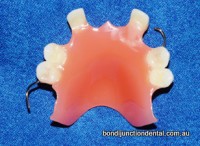
Part plastic upper denture
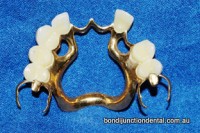
Part metal upper denture with thinner skeleton metal framework
Keeping Teeth and Roots
Keeping teeth helps retain the bone and stops the bone and gum from shrinking. Occasionally teeth roots are retained and dentures are built over the roots. See section on Over Dentures below.
Lower jaw:-
It is important to retain as many teeth as possible, especially in the lower arch. Keeping the teeth or even just the roots will stop the jaw bone from resorbing (shrinking). Maintaining the bone results in a greater surface area for the denture to sit, resists sliding and helps to distribute biting load over a greater area.
Upper Jaw:-
Patients who have only one or two teeth remaining teeth in the upper jaw may be better off removing all remaining teeth to establish suction in the upper arch.
An upper denture performs better if suction can be achieved than trying to stabilise a denture where there are too few teeth for a denture to adequately clasp.
Advantages:
Less expensive than bridgework or implants
Good aesthetics and functional
Can usually add more denture teeth as other natural teeth are lost
Easy to repair
Disadvantages:
The part denture framework has to grip natural teeth some distance away from where the missing teeth for stability.
As a result part dentures extend to other parts of the mouth.
Some loss of taste and sensation may occur especially with plastic dentures.
OVER DENTURES:-
Dentures can be made over the top of remaining teeth, roots or implants which can then be used as anchors to hold the denture.
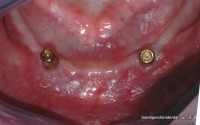
Implants with press studs
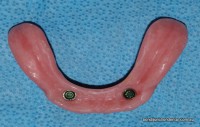
Press studs in dentures clip onto studs in implants
Overdenture Advantages:
Keeping the roots allows better tactile sense as patients can feel the biting pressure transmitted through the denture onto the roots.
Retained roots maintain bone bulk and stop resorption.
Patients can deliver stronger chewing power.
The simplest of all over denture retention systems is the use of Magnetically Retained Overdentures.
A stainless steel restoration may be placedover a retained root apposing miniature magnets placed into the denture base.
Magnetic retention results in much greater denture stability.
Similarly precision attachments can be placed on roots or implants to engage clips or studs in the under surface of dentures giving even greater retention.
The best stability is achieved with implant clips or stud attachments.
Overdenture Disadvantages:
Retained roots usually need nerve treatments and a restoration on top of the root.
Precision attachments and implants are complex treatment options adding to expense, time and patient commitment.
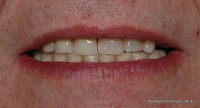
Patient is wearing a part upper plastic (right side only) denture extending to the mid line and an overlay implant press stud retained full lower denture